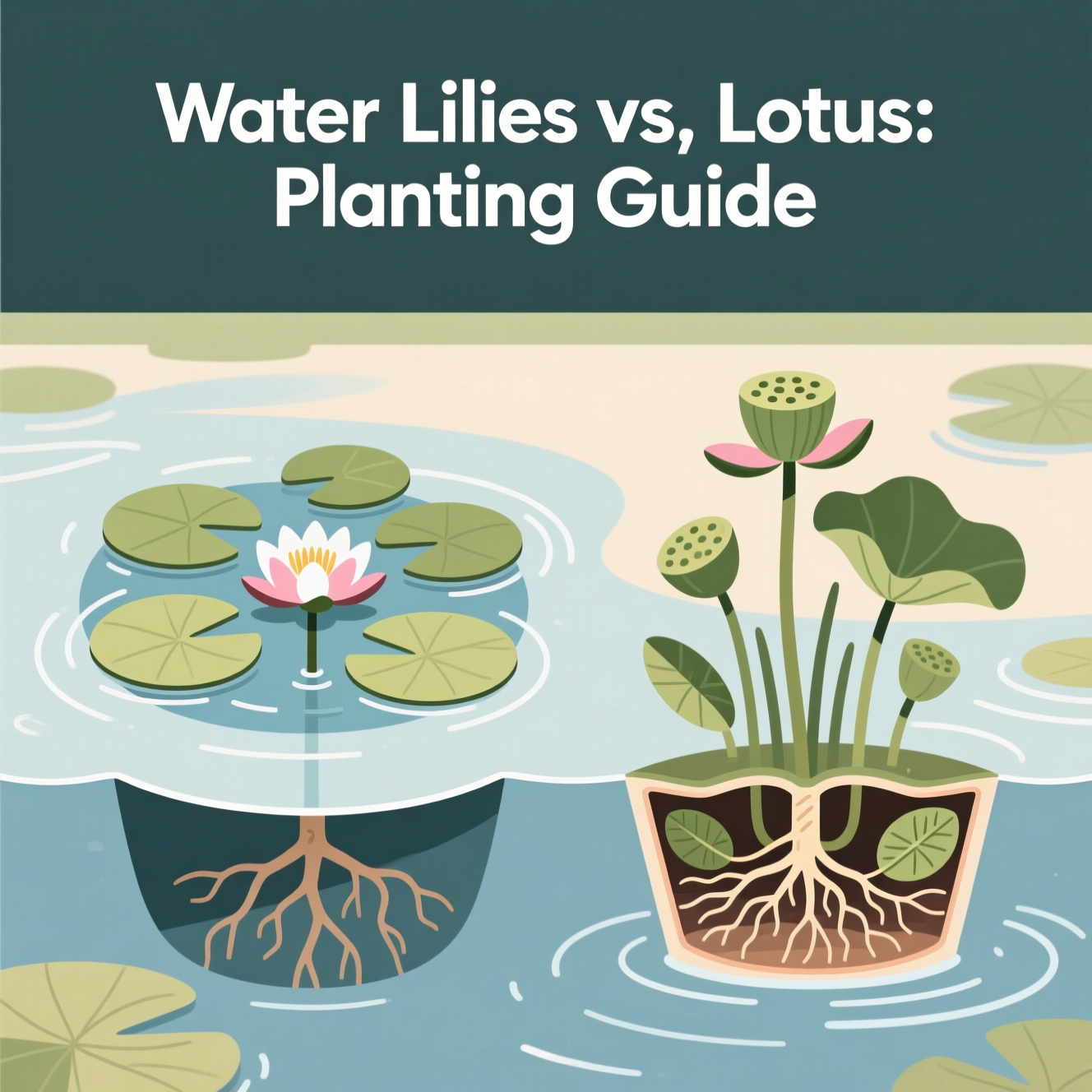What Are the Key Differences Between Water Lilies and Lotus Flowers?
Distinguishing between water lilies and lotus flowers involves examining their distinct botanical structures. Water lilies, belonging to the Nymphaea genus, typically display ovate leaves with a central notch. These leaves float serenely on the water’s surface. Lotus flowers, from the Nelumbo genus, present a striking contrast with their large, peltate leaves. These distinctive, umbrella-shaped leaves often rise several feet above the water.
In practical terms, this difference in leaf structure significantly impacts their aquatic appearance and environment. Lotus leaves can achieve impressive diameters, sometimes reaching up to 2 feet (60 cm), showcasing remarkable botanical resilience. Water lily leaves, by comparison, are generally smaller and remain immersed or floating. Furthermore, lotus flowers are known for their larger size and more upright orientation compared to the typically flatter water lily blooms. Both species are valued aquatic plants, but their growth habits and leaf morphology clearly define their unique characteristics, distinguishing their ornamental roles.
How Do Their Blooms Differ in Appearance and Blooming Period?
Water lily and lotus blooms present distinct visual characteristics and bloom cycles, crucial for aquatic garden enthusiasts. Water lilies often exhibit a star-like formation, showcasing numerous petals and a well-defined pistil and stamen structure. Their flower appearance is typically diurnal, opening with the sun and closing each evening, as noted by horticultural guides.
Lotus flowers, in contrast, are renowned for their dramatic presence and a prominent, pineapple-like seed pod. Their bloom cycle is often extended, with individual flowers potentially lasting several days. This extended flowering time, combined with their often described ‘divine’ aesthetic, sets them apart. Many water lily varieties bloom from late spring to early autumn, while lotus flowers typically peak in mid-summer, offering diverse flowering periods for garden design.
What Are the Habitat and Water Depth Requirements for Each?
Understanding the specific pond conditions and water depth is vital for aquatic plant success. Water lilies thrive in relatively shallow water, requiring about 6 inches to 2 feet (15–60 cm) of water above their submerged roots. This ensures their rhizomes receive adequate sunlight and warmth essential for healthy growth in an aquatic garden habitat. For most gardeners, maintaining this consistent water level is key.
Lotus flowers, conversely, demand deeper water to flourish. They typically need 2 to 4 feet (60–120 cm) of water above their tubers, especially within larger pond liner installations. This greater depth helps regulate temperature and supports their more robust growth habit. Proper planting depth is crucial, with an incorrect depth potentially leading to over 50% reduced flowering for lotus, significantly impacting their visual appeal.
Why Do Gardeners Choose Water Lilies Over Lotus Flowers?
Gardeners often select water lilies for their vibrant color palette and manageable size. Water lilies exhibit a more compact growth habit, making them ideal for smaller ponds and water features. This variety offers a broad spectrum of bloom forms and colors, appealing to diverse aesthetic preferences. Furthermore, their disease resistance is generally more robust than that of lotus flowers.
The diverse hybridizing of water lilies has resulted in over 1000 documented cultivars, offering unparalleled choice. This extensive range ensures gardeners can find a perfect fit for their aquatic garden. In practical terms, many find water lilies require less maintenance, simplifying upkeep for busy enthusiasts. This ease of care contributes significantly to their popularity as easy aquatic plants.
Why Do Gardeners Choose Lotus Flowers Over Water Lilies?
Gardeners often select lotus flowers for their dramatic presence and architectural beauty. The lotus offers majestic blooms that stand tall above the water, creating a striking focal point. This upright growth habit, combined with their bold foliage, makes them ideal for large water bodies and ponds. Their significant cultural symbolism, particularly the white lotus, also contributes to their appeal for those seeking deeper meaning in their aquatic landscapes.
Lotus flowers are chosen for their superior aesthetic impact and rich symbolic value. The white lotus, for instance, is revered in over 20 major religions worldwide, symbolizing purity and enlightenment, as noted by various botanical resources. This deep cultural resonance enhances their desirability for symbolic flowers. Their impressive stature and robust nature offer a distinct advantage in large water gardens, providing a sense of grandeur not always matched by water lilies.
Can Lotus and Water Lilies Be Grown Together?
Growing lotus and water lilies together is technically possible, but requires understanding their distinct environmental needs. Successful mixed aquatic planting depends on careful management within a shared ecosystem. For most gardeners, achieving harmony involves managing competition for space and nutrients, especially in container gardening setups.
In larger ponds, intercropping can work if distinct depth zones are maintained. Lotus prefer deeper water, while lilies thrive in shallower areas. Successful cohabitation often depends on maintaining a difference of at least 1–2 feet (30–60 cm) in water depth between the two plant types. This separation helps manage competition for light and root zone space. Ensuring adequate nutrient uptake for both species is crucial; over-fertilization can harm lilies while insufficient nutrients stunt lotus growth.
Furthermore, their differing growth habits mean careful spacing is essential to prevent root entanglement. Without proper planning, one species may outcompete the other, leading to reduced vigor or bloom. Therefore, while companion aquatic plants can enhance pond aesthetics, understanding their specific requirements is key to preventing detrimental competition.
What Are the Best Practices for Planting Both Species?
Planting water lilies and lotus flowers requires specific techniques for optimal growth. Use specialized aquatic soil or a heavy loam mix. Standard potting soils can disintegrate, harming your pond’s water clarity. For most gardeners, preparing the right substrate is key to successful aquatic plant care.
Select containers appropriate for each plant. Water lilies thrive in wide, shallow pots, while lotus require deeper, wider ones to accommodate their growth. Always ensure the rhizome is planted with its growing tip pointing upwards. Apply slow-release fertilizer tabs near the roots for sustained nutrient uptake. Studies indicate that using a soil mix with at least 30% clay content significantly improves soil stability and nutrient retention.
Proper pond planting guide practices also include understanding dormancy and seasonal care. Using mesh pots can help manage plant spread. This approach is crucial for effective how to plant lotus and how to plant water lily, contributing to a healthy garden pond setup.

Tyler Grant runs our Tools & DIY testing lab, putting pruners, hoses, drip kits, and raised-bed systems through real-garden use. He documents builds, timings, and durability to deliver honest pros/cons and clear recommendations across budgets. Tyler’s guides include safety callouts, maintenance checklists, and step photos you can follow in a weekend.

